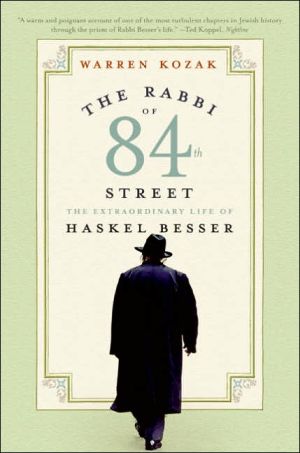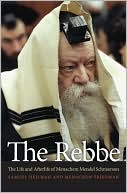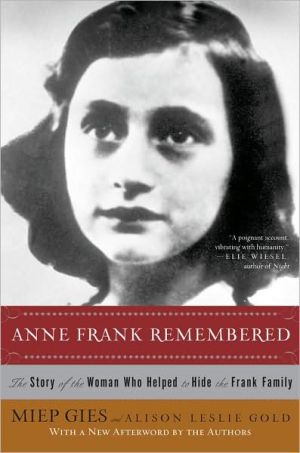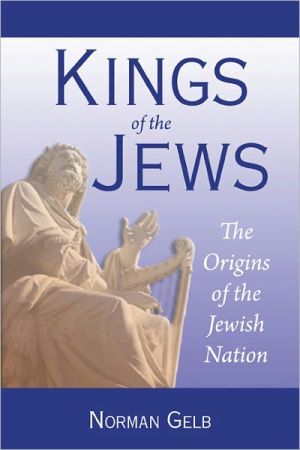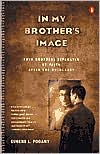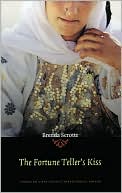Rabbi of 84th Street: The Extraordinary Life of Haskel Besser
Always wearing an easy smile, Hasidic rabbi Haskel Besser spreads joy wherever he goes, enriching the lives of his many friends and congregants with his profound understanding of both Orthodox Judaism and humannature.\ With warmth and admiration, journalist Warren Kozak writes about the rabbi's extraordinary life—from his family's escape to Palestine in the late 1930s to his witnessing of Israel's rebirth in 1948, to his move to New York City, where he lives today.\ A rare window into the...
Search in google:
Always wearing an easy smile, Hasidic rabbi Haskel Besser spreads joy wherever he goes, enriching the lives of his many friends and congregants with his profound understanding of both Orthodox Judaism and human nature.With warmth and admiration, journalist Warren Kozak writes about the rabbi's extraordinary life—from his family's escape to Palestine in the late 1930s to his witnessing of Israel's rebirth in 1948, to his move to New York City, where he lives today.A rare window into the normally closed world of Hasidic Jews, The Rabbi of 84th Street is also the story of Judaism in the twentieth century; of the importance of centuries-old traditions; and of the triumph of faith, kindness, and spirit. Publishers Weekly Although Besser is the rabbi of an unobtrusive shtibel (small synagogue) on Manhattan's Upper West Side, it may be more accurate to define him as a hero who has admirers and devotees all over the world. In this down-to-earth and endearing biography, we first meet Besser, the son of a successful Hasidic businessman in Katowice, Poland, in his deeply religious yet modern European home that was a center of activity and a magnet for notables and guests. When he was 16, however, the boisterous life he had known soured as the Nazis came to power and he and his family fled to Palestine to escape the escalating anti-Semitism. Childhood influences, especially his father's close relationship with the Radomsker rebbe, a Hasidic spiritual leader, and his mother's affinity for theater stayed with him and inspired a lifelong love for Hasidism and Torah as well as for classical music and culture. (This has proved a source of solace to him and amazement to others; he can identify any classical piece on the radio in seconds.) But it is not just the rabbi's vast spiritual and secular knowledge that has won him the respect of presidents, business leaders and even assimilated Jewish children; it is a tangible loyalty and commitment to his fellow human beings. At 81, his energy has not waned; he still gives a daily Talmud class at 6:30 a.m. and embarks on international humanitarian trips. Kozak's inspiring and poignant biography of this legendary man is a wonderful concoction of fascinating details and enlightening stories. (July 6) Copyright 2004 Reed Business Information.
The Rabbi of 84th Street\ The Extraordinary Life of Haskel Besser \ \ By Kozak, Warren \ HarperCollins Publishers\ ISBN: 006051101X \ \ \ Chapter One\ Crossing the Street\ What Haskel Besser does best -- and he does a lot of things very well -- is demolish any preconceptions people may have of religious Jews.\ On the one hand, he is indeed a Hasidic rabbi with a black suit, a black fedora, and that long gray beard. His appearance is always immaculate and he never deviates from it, no matter what the season. If he's just going down to the corner to buy a newspaper, he wears a suit with a vest, starched white shirt with cuff links, and a tie.\ Partly that's because of the European tradition in which he was raised. But this immaculate attention to image also gives away another detail of his personality. He understands his context in the greater, non-Jewish world, and he knows that when he walks out his door, people will judge not Haskel Besser, but all rabbis and, hence, all Jews, by the way he conducts himself. That's never far from his mind and accounts, in part, for his courtly manners that are both charming and somewhat out of place in twenty-first-century America. This is a gentleman in the old sense of the word. It is also someone who takes his position very seriously.\ Besides the suit and tie, there is one more crucial piece of attire: he always has a yarmulke on his head -- outside, inside, anywhere. (And on Shabbos and Jewish holidays, he wears a streimel -- a round, fur hat Hasidic men don on special occasions.)\ Many years ago, when Haskel Besser was a young man living in British Palestine, a prospective colleh (bride) asked him why he continued to wear this outfit, which may have made sense in Poland, but seemed to make no sense in the airless humidity and heat of Tel Aviv.\ "She had a point," the rabbi admits. "It was uncomfortable. But I dressed that way then and now because my father and his father did the same."\ Traditions, for Rabbi Besser, come in all sorts of large and small packages and he considers all of them important. But there is another crucial facet to this man's personality that sets him apart from many other equally observant Jews who dress the same way and follow the customs of their forefathers. He is also very much a part of the outside, non- Jewish world. His circle of friends includes Jews and non- Jews. He has a deeply sophisticated knowledge of literature, music, and politics. And while his understanding of Talmud and Torah is legendary and he is respected by the most famous rebbes in the world, his admirers extend far beyond that world. He has been an invited guest at White House dinners and presidential inaugurations. He is the recipient of one of Poland's highest civilian medals and he is admired throughout Germany and Austria. He even counts the president of Romania as a good friend. But power brokers are hardly the epicenter of the rabbi's life.\ With a unique sense of humor and a special knack for telling a story, he is also a master of the disarming gesture. The rabbi has been known to be distracted by moths.\ One Friday night, a moth was flitting about the window of the Besser dining room during the Shabbos dinner. The candles were glowing, the rich, warm smells of dinner wafted through the room, and the rabbi got up to open the window to let the confused insect outside.\ "It looks like the butterfly would rather be out than in," he said.\ A guest corrected him: "It isn't a butterfly, it's a moth."\ "I know," the rabbi responded with that smile, "but it's Shabbos and I wanted the moth to feel a little better about itself. Everyone should feel better on Shabbos."\ All creatures -- high and low -- get equal treatment.\ The Shtibel\ Rabbi Besser has a definite destination when he leaves his house at 6:30 every morning. It's the same trip he has made daily for the past fifty years: he crosses the street.\ The destination is a brownstone house that, except for the discreet Hebrew lettering over the front door, looks like all the other brownstones on this residential block of Manhattan's Upper West Side. But walking through the front door of that brownstone is like walking through a portal into another era. You could easily be in Eastern Europe a century ago.\ At 6:30 in the morning, the rabbi is often the first person to arrive. He goes through the usual ritual of unlocking the door, turning on the lights, and walking up the stairs, perhaps a bit slower than he once did. Sometimes "Doc," his friend and the unofficial caretaker of the building (Doc's day job is cardiology), gets there first and takes care of these mundane details. But the rabbi is happy to do them himself.\ The initial observation of a first-time visitor to this brownstone is how unfancy everything is. The first floor contains only a metal coatrack with wire hangers. There's a small sink for washing hands and a bulletin board with various community announcements tacked up in a haphazard way. On the right is the staircase, covered by a frayed and wornout carpet, which leads to the main room on the second floor. It smells a little like the stacks of a university library containing endless shelves of books dating back to the nineteenth century.\ At the top of the steps, a plain curtain separates you from the main room of the building. Pulling it back leads to the next surprise: a scene of what appears to be complete disorganization. Prayer books are scattered on various tables, and the chairs and tables are set in what appears to be a completely random way.\ Although this is a house of worship, it is unlike most of the thousands of synagogues and churches throughout the United States where pews are placed in strict regimental order, all facing the front ...\ Continues... \ \ \ \ Excerpted from The Rabbi of 84th Street by Kozak, Warren Excerpted by permission.\ All rights reserved. No part of this excerpt may be reproduced or reprinted without permission in writing from the publisher.\ Excerpts are provided by Dial-A-Book Inc. solely for the personal use of visitors to this web site. \ \
\ Elie Wiesel"A moving portrait of a warm person."\ \ \ \ \ Publishers WeeklyAlthough Besser is the rabbi of an unobtrusive shtibel (small synagogue) on Manhattan's Upper West Side, it may be more accurate to define him as a hero who has admirers and devotees all over the world. In this down-to-earth and endearing biography, we first meet Besser, the son of a successful Hasidic businessman in Katowice, Poland, in his deeply religious yet modern European home that was a center of activity and a magnet for notables and guests. When he was 16, however, the boisterous life he had known soured as the Nazis came to power and he and his family fled to Palestine to escape the escalating anti-Semitism. Childhood influences, especially his father's close relationship with the Radomsker rebbe, a Hasidic spiritual leader, and his mother's affinity for theater stayed with him and inspired a lifelong love for Hasidism and Torah as well as for classical music and culture. (This has proved a source of solace to him and amazement to others; he can identify any classical piece on the radio in seconds.) But it is not just the rabbi's vast spiritual and secular knowledge that has won him the respect of presidents, business leaders and even assimilated Jewish children; it is a tangible loyalty and commitment to his fellow human beings. At 81, his energy has not waned; he still gives a daily Talmud class at 6:30 a.m. and embarks on international humanitarian trips. Kozak's inspiring and poignant biography of this legendary man is a wonderful concoction of fascinating details and enlightening stories. (July 6) Copyright 2004 Reed Business Information.\ \ \ Library JournalThis loving, simply written portrait of Hasidic Rabbi Haskel Besser reflects a friendship that has grown between the author and his subject over 15 years. The biography surveys the rabbi's life through a narrative pastiche of stories and events that have shaped him (and events he has helped to shape). Kozak, a secular Jewish journalist, provides insight into the Hasidic world in general and the lives this Upper West Side rabbi has touched in particular. With boundless energy, at 81, Rabbi Besser starts his day by offering a Talmud class at 6:30 a.m. and returns home well after midnight. He travels the world, serving as a confidant to political and business leaders. For example, after befriending ambassador and business leader Ronald Lauder, Rabbi Besser embarked upon a humanitarian mission to help Polish Jews after the fall of communism. Readers looking for psychological or spiritual insights may be disappointed, but this book allows them to share in some of his wisdom.-Herbert E. Shapiro, Empire State Coll., SUNY, Rochester Copyright 2004 Reed Business Information.\ \
